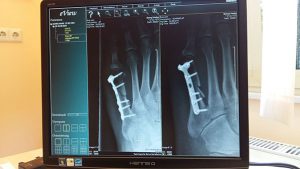As Heraclitus said more than 2,000 years ago, there is nothing permanent except change. If you’ve been injured, it can change your life. Sometimes the twisting road to recovery includes implanted surgical hardware. Whether screws, plates, or pins, these strengthen the impacted area so your body can heal and mobility is restored. How long they stay is up to the surgeon and your healthcare team but when it’s time to say goodbye, removal is as easy as an outpatient trip to Pacific Surgical Center (PSC).
Researchers explain that “Orthopedic implants are categorized into two groups including permanent joint replacements and temporary fracture fixation devices. Permanent orthopedic implants include the hip, knee, ankle, shoulder, elbow, wrist, and finger joints, which are expected to serve in the human body throughout the life span of the patients. On the other hand, temporary orthopedic implants including plates, screws, pins, wires, and intramedullary nails are needed to fix broken or fractured bones and are supposed to serve for a relatively short time just long enough to let bones heal.”
 Skilled orthopedists, like PSC’s team of highly trained physicians, research the issue thoroughly before proceeding. Industry experts say that “an orthopedic implant is a manufactured device designed to replace a joint, bone, or cartilage due to damage or deformity—such as from breaking a leg, losing a limb, or a congenital defect. Your doctor’s decision to replace a damaged natural part with a manufactured medical device like an orthopedic implant is not an easy one, as there are always risks involved with surgery. But the benefits might outweigh those risks. For example, without an implant or prosthetic, a patient may be confined to a wheelchair when the ability to walk again is still completely possible.”
Skilled orthopedists, like PSC’s team of highly trained physicians, research the issue thoroughly before proceeding. Industry experts say that “an orthopedic implant is a manufactured device designed to replace a joint, bone, or cartilage due to damage or deformity—such as from breaking a leg, losing a limb, or a congenital defect. Your doctor’s decision to replace a damaged natural part with a manufactured medical device like an orthopedic implant is not an easy one, as there are always risks involved with surgery. But the benefits might outweigh those risks. For example, without an implant or prosthetic, a patient may be confined to a wheelchair when the ability to walk again is still completely possible.”
Devices are crafted from cutting edge metal alloys, ceramics, and polymers. Metal hardware can last for more than 10 years and is typically used in high-impact hip and knee replacements. Ceramics are used when bones have become more fragile due to aging or osteoporosis. Polymers often substitute for cartilage and ligaments in our joints.
Hardware removal is done when the injury has healed, the device needs to be replaced, or there are rejection issues within the body. The U.S. National Library of Medicine describes that patients are either numbed with local anesthesia or put to sleep under general anesthesia. Doctors monitor blood pressure, heart rate, and breathing throughout the procedure. “During the surgery, your surgeon may: Open the original incision or use new or longer incisions to remove hardware, remove any scar tissue that has formed over the hardware, [and] remove the old hardware. Sometimes, new hardware may be put in its place…Your surgeon will close the incision with stitches, staples, or special glue. It will be covered with a bandage to help prevent infection.”
As with any surgery, healing requires rest, patience, and support. “How long it takes to recover depends on whether you have had other procedures, such as a bone graft,” say NLM doctors. “Ask your provider how long it may take to heal so you can resume all your regular activities. Most people have less pain and better function after hardware removal.”
 At PSC, outpatient hardware removal is one of the many clearly posted items on their transparency pricing list. Whether determined complex or simple, this dedication to up-front cost means no sticker shock down the road. Their price includes facility fee, surgeon’s fee, and anesthesiologist’s fee and caring staff will help bill your insurance if needed. Though for many policies, PSC’s cash pricing is less than the coinsurance and copayment red tape.
At PSC, outpatient hardware removal is one of the many clearly posted items on their transparency pricing list. Whether determined complex or simple, this dedication to up-front cost means no sticker shock down the road. Their price includes facility fee, surgeon’s fee, and anesthesiologist’s fee and caring staff will help bill your insurance if needed. Though for many policies, PSC’s cash pricing is less than the coinsurance and copayment red tape.
“At Pacific Surgical Center, we offer a very attractive alternative to hospital-based surgery, eliminating common concerns most people have,” explains staffers. “Your experience will involve exceptional care with easier access, more privacy, less paperwork, greater comfort, and less stress than if your procedure were performed at a hospital. Our physicians use the most advanced surgical equipment and technology available. This ensures that your procedure will be fast, comfortable and minimally invasive; and it also will require less recovery time than a surgical procedure performed using older methods and instruments.”
One of the most exciting phrases to hear is ‘the end is in sight.’ After illness or injury, it’s easy to become discouraged by your inability to do the everyday chores, hobbies, and interpersonal interactions that make up daily life. But when you’re given the official go-ahead by your doctor, call PSC at 360-442-7900 or request a specialist online to get started on your hardware removal surgery.


